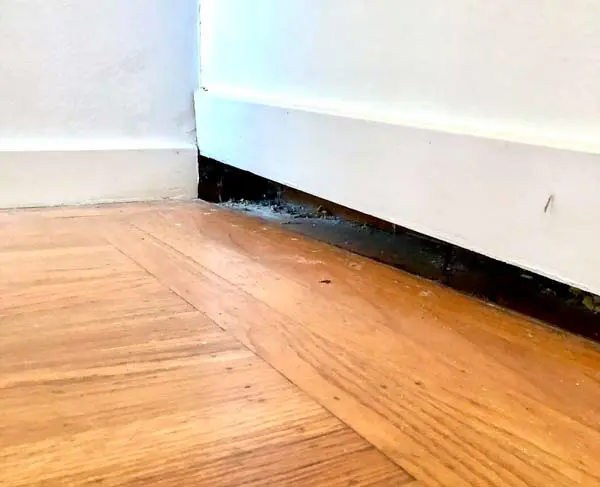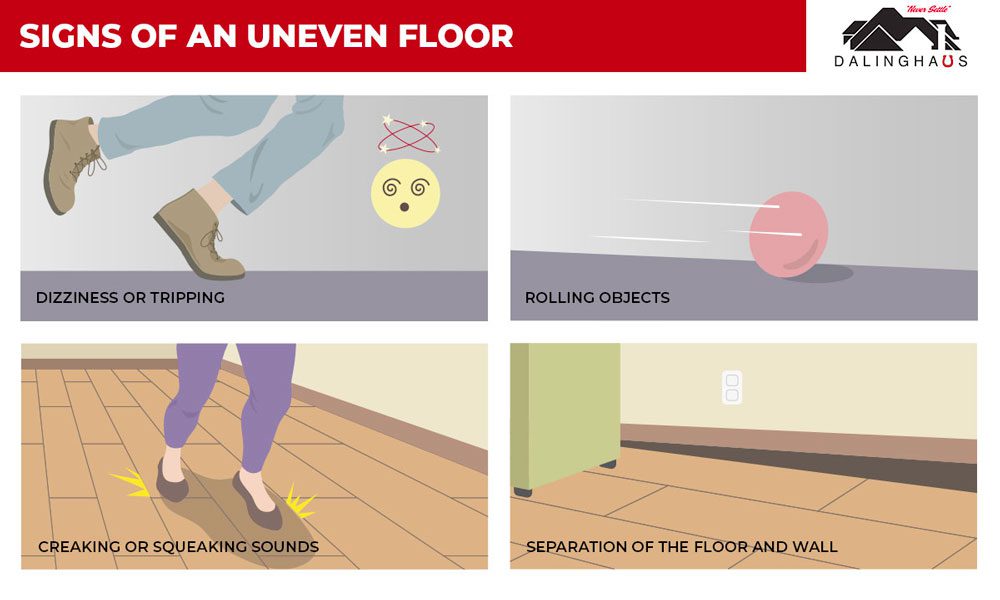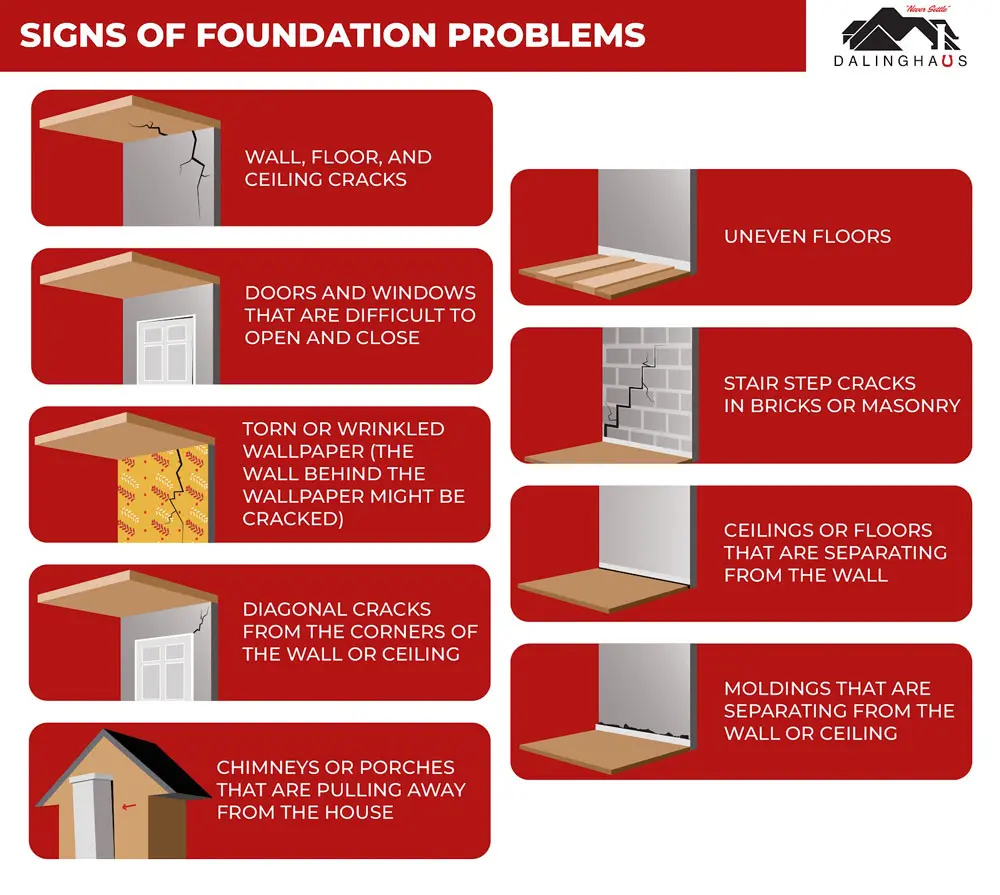
If you’re looking for repair solutions for uneven floors online, you’ll find numerous sources offering DIY fixes and quick solutions. However, before you invest your time and money in these repairs, take a moment to read this article. We’ll discuss why your floors may be uneven, the importance of timely repairs, and the correct way to repair your sloping floors. By doing so, you’ll avoid the headache of multiple temporary fixes.
Most Common Causes of Uneven Floors
Uneven or sloping floors can indicate underlying issues in a building’s structure or foundation. Some of the most common causes include:
- Foundation Settlement – Over time, the soil beneath the foundation may settle unevenly, leading to differential settlement and causing sections of the foundation to sink or shift. Uneven settling of your foundation can result in sloping or uneven floors throughout the building.
- Poor Soil Conditions – Expansive soils, such as clay soils, can expand and contract with changes in moisture levels, leading to uneven settling of the foundation. Similarly, poorly compacted or loosely packed soils may compress under the weight of the building, causing the foundation to sink or settle unevenly.
- Water Damage – Water intrusion and moisture problems can compromise the foundation’s structural integrity and lead to uneven floors. Excessive moisture can weaken the soil beneath the foundation, causing it to erode or shift over time. It can also lead to the rotting of wood and the deterioration of support beams, causing the floors to sag or slope in certain areas.
- Poor Construction Practices – Inadequate construction techniques or substandard building materials can lead to structural problems and uneven floors. Improperly installed footings, inadequate reinforcement, or insufficient support beams may result in uneven floors.
- Termite Damage – Termite infestations can weaken wooden support beams, floor joists, and subflooring, causing them to sag or settle unevenly.
- Natural Disasters – Earthquakes, landslides, or other geological events can disrupt the soil and foundation, leading to differential settlement and uneven floor surfaces.
How Can You Tell If Your Floor Is Uneven?
While some homeowners can readily tell by looking at their floors that they are uneven, it can be harder to spot sloping floors during the early phases of foundation settlement or crawl space damage. If you are unsure whether your floors are genuinely uneven, try looking for the following signs:
- Dizziness or Tripping – If you start to feel dizziness or vertigo while walking around your home, this could be a sign of uneven floors. Also, the floor could be uneven if you trip or have an uneven gait while walking through certain areas of your home.
- Rolling Objects – Place a marble or small ball on the floor. If the object rolls or moves in a particular direction, it may indicate sloping or unevenness of the floor.
- Creaking or Squeaking Sounds – Uneven floors may produce creaking or squeaking sounds when walked upon, especially in areas where the floorboards or subflooring are uneven or not adequately supported.
- Separation of the Floor and Wall – If you notice uneven gaps between your baseboards and the floor, your floor is likely sloping.

Why Shouldn’t You Ignore Uneven Floors?
Ignoring uneven floors can lead to several potential issues, including safety hazards, structural damage, and decreased property value. Here are some reasons why you shouldn’t ignore uneven floors:
- Safety Hazards – Uneven floors pose a tripping and falling hazard, especially for elderly individuals, children, or those with mobility issues.
- Structural Damage – Uneven floors may indicate underlying structural problems, such as foundation settlement, rotting wood, or termite damage. Ignoring these issues can allow them to worsen over time, potentially leading to more extensive structural damage and costly repairs.
- Increased Wear and Tear – Uneven floors can cause excessive wear and tear on flooring materials, such as hardwood, laminate, or tile. Uneven surfaces may cause tiles to crack, hardwood to warp, or carpet to wear unevenly, creating the need for premature replacement.
- Decreased Property Value – Uneven floors can detract from the overall appearance and value of the property. Potential buyers may view uneven floors as a red flag indicating structural problems or deferred maintenance.
Other Signs You May Have Foundation Issues
Identifying whether uneven floors are due to foundational issues is difficult without professional inspection. However, you may also notice other problems that point to foundation damage, such as:
- Visible Cracks – Cracks in the foundation, walls, floors, or ceilings are often one of the most obvious signs of foundation problems. These cracks may be horizontal, vertical, diagonal, or stair-step patterns and can vary in width and length.
- Doors and Windows are Misaligned – Difficulty opening or closing doors and windows, or doors and windows that no longer latch properly, may indicate foundation movement or settlement. Gaps between window or door frames and the surrounding walls may also suggest that the foundation has shifted or settled unevenly.
- Bowed or Leaning Walls – Walls that appear to bow, lean, or tilt inward or outward may indicate foundation movement or structural issues.
- Stair-Step Cracks in Brick or Masonry – Stair-step cracks in exterior brick or masonry walls are a telltale sign of differential settlement.
- Moist Crawl Space – Water in the crawl space is a sign of foundation issues caused by cracks or gaps that allow water infiltration.

How to Properly Repair an Uneven Floor
Properly repairing an uneven floor requires understanding and resolving the source of the problem. Consider the following solutions:
- Foundation Underpinning – If your foundation is settling unevenly, you may need push or helical piers installed. Push and helical piers connect your home’s foundation to stable strata or bedrock and raise it to the maximum practical level, offering permanent stability and leveling your floors.
- Crawl Space Jacks – If your floors are sloping because the floor joists lack sufficient support, crawl space jacks can lift and stabilize the floor.
- Post and Pad Replacement – Posts and pads in your crawl space can deteriorate over time, leading to sloping or sagging floors. In some cases, replacing the posts and pads is the best way to repair your uneven floor.
- Crawl Space Waterproofing – If your uneven floors were mainly caused by moisture in your crawl space, then encapsulating your crawl space and adding a drainage system and a dehumidifier may be essential to prevent your floors from becoming uneven again.
DIY Repairs for Uneven Floors You Should Avoid
Repairing uneven floors can be a complex and potentially risky task, particularly if you lack the necessary expertise or experience. Attempting DIY repairs without proper knowledge or professional guidance can lead to further damage or safety hazards. Here are some DIY uneven floor repairs to avoid:
- Self-leveling Compound – While self-leveling compounds can be effective for minor leveling or patching uneven floors, they may not address underlying structural issues or provide long-lasting solutions. In some cases, using a self-leveling compound can exacerbate the root problem by adding weight to a weak subfloor.
- Adding New Flooring Materials – Installing new flooring materials, such as laminate, hardwood, or tile, over an uneven subfloor can exacerbate the problem and lead to premature wear and damage to the new flooring. Uneven subfloors should be leveled appropriately and prepared before installing new flooring materials to ensure a stable and durable surface.
- DIY Jacking or Shimming – Attempting to lift or level sagging floors yourself by jacking or shimming can be dangerous and may cause further damage to the structure. Improperly applied force or inadequate support can lead to structural failure, injury, or property damage.
- Overlooking Moisture Issues – Ignoring moisture issues or failing to address them before attempting repairs can lead to mold growth, wood rot, and structural damage over time.
- DIY Foundation Repairs – Attempting DIY foundation repairs, such as patching cracks or concrete leveling, without proper knowledge or expertise can result in ineffective repairs and may worsen the problem. Foundation repairs require specialized equipment and techniques and should be left to qualified professionals.
Don’t ignore your uneven floors any longer. Find out if your uneven floors are due to foundation damage or just a few damaged pads by scheduling an inspection with our foundation repair experts. At Dalinghaus Construction, we pride ourselves on offering our customers the necessary information and repair services to provide them with peace of mind for decades. Contact us today if you live in Southern California, Nevada, or Arizona.






